The drake American Black Duck at Loch Sunart (Highland) has been present in the area intermittently since 16th June 2007, primarily spending its time in the bay at Strontian (NM813613). This year, it has been reported with unusual regularity and has starred as an attraction to many birders visiting western Scotland to take in other sought-after vagrants such as American Herring Gull and Snow Goose. By early February, it was clear that the bird was paired with a female Mallard (it was observed copulating on 6th), and it has since moved upriver from the bay to a small, fast-flowing and wooded stream — seemingly suitable breeding habitat for the latter species at least. It was still present on 25th March, but there has been no sign since.
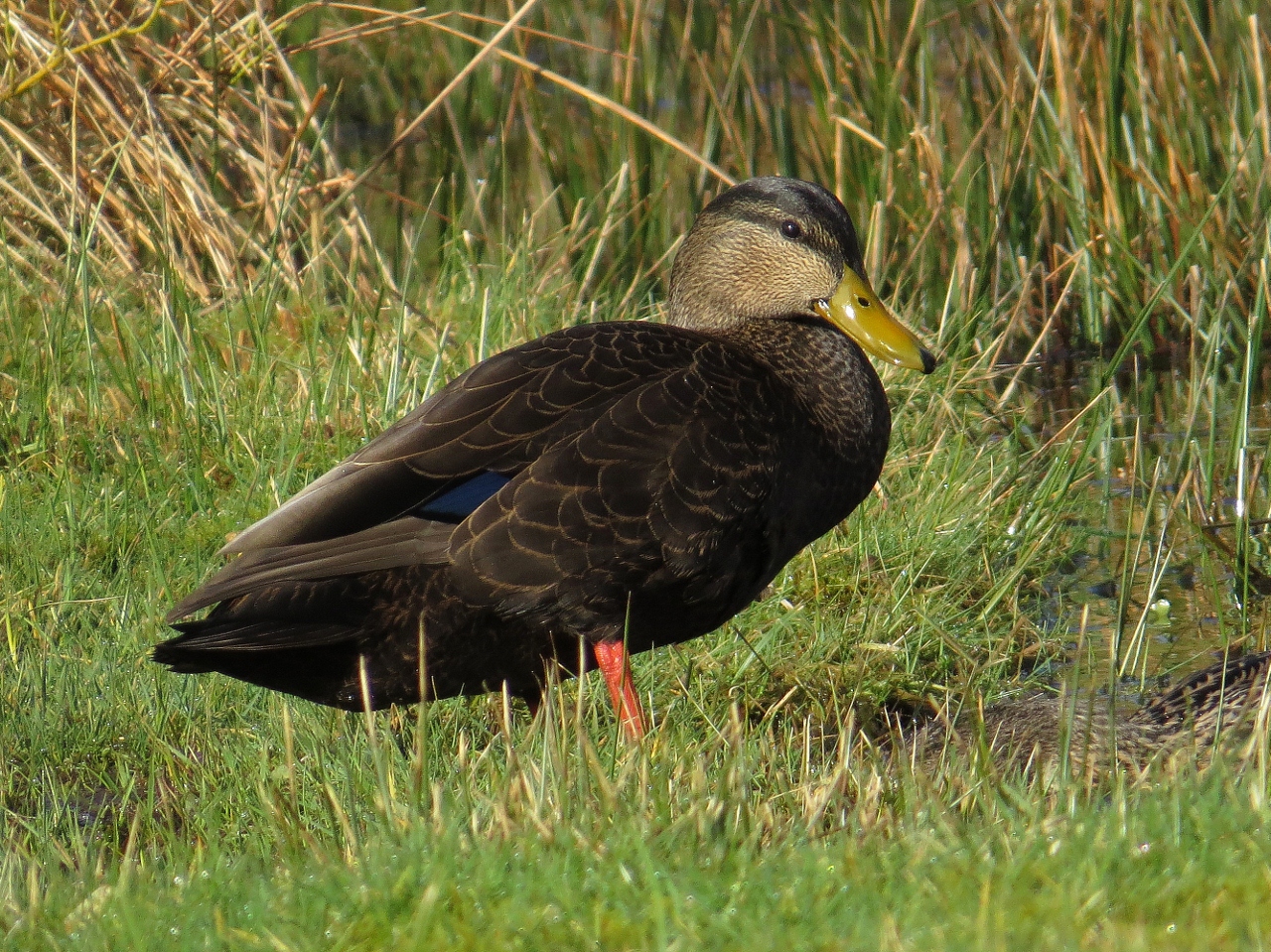
Adult drake American Black Duck, Strontian, Highland, March 2014 (Photo: Kris Gibb).
Though present in the area on and off for almost seven years, the bird has often proved highly mobile and elusive and, as a result, any previous breeding activity has been difficult to observe. Nevertheless, evidence points towards the bird having already fathered ducklings in the area; when it was seen on 23rd December 2012 it was alongside a drake American Black Duck × Mallard hybrid, which also seemed to be paired with a female Mallard. A female hybrid has also been seen in the area, with a second male hybrid also reported. With the bird's habits seemingly worked out this year, there is hope that we may learn more about its breeding behaviour and any successes that it has this season.
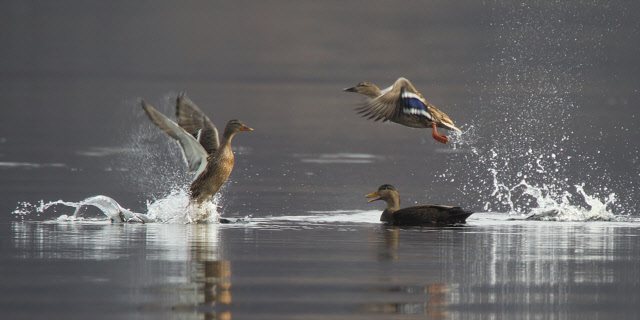
Drake American Black Duck interacting with two female Mallards, Strontian, Highland, February 2014 (Photo: Ian Fulton).
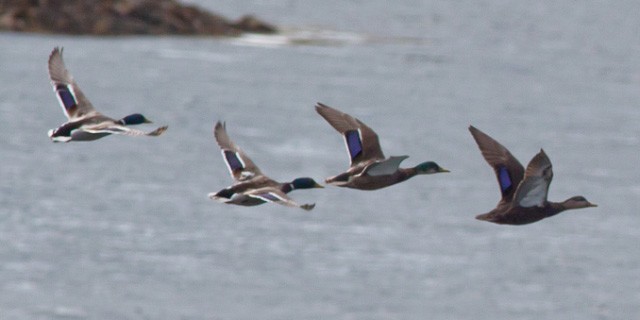
Left to right: two drake Mallards, drake American Black Duck × Mallard and drake American Black Duck, Strontian, Highland, 21st June 2011 (Photo: Martyn Sidwell).
Given the regularity of recent records, it is perhaps surprising that American Black Duck's history in the British Isles goes no further back than 1954, when a female was shot near Mullinavat (Co Kilkenny). It was just over seven years until the next bird at North Slob (Co Wexford), followed by another shot in the same county in November 1966, a little under four months before the first British bird at Stoke (Kent). American Black Duck has been recorded in Britain and Ireland in 35 of the subsequent 47 years, and this regularity raises the question as to whether the species had previously been overlooked both in the field and in wildfowlers' bags, due to its similarity to that most familiar of ducks, the Mallard. That said, the volume of records masks the number individuals involved — many records relate to long-staying or returning birds, and thus American Black Duck is no doubt rarer than the above statistic suggests.
American Black Duck (Anas rubripes) readily interbreeds with Mallard (A. platyrhynchos) in North America, and hybridisation has been identified as a cause of decline in its populations. Habitat changes induced by human activity have led to a widening of Mallard's range into the east where, in the absence of its close relative, American Black Duck was once a particularly popular wild duck for the table. Given that vagrant American Black Ducks often stay a long time once they arrive in Western Europe — sometimes a number of years — it makes sense that they have been known to pair, and even breed, with local Mallards.
American Black Duck × Mallard hybrids are variable, and will normally show at least one of a suite of characters that set them apart as being of mixed parentage. This may include pale markings on the flanks, scapulars and/or outer tail feathers, while white-tipped greater coverts, pale grey tertials and warm brown fringes to the breast feathers may also hint at a bird of impure origin. In drakes, variable amounts of green colouring are generally present on the head and/or uppertail coverts, while some show the curly tail feathers characteristic of drake Mallard.
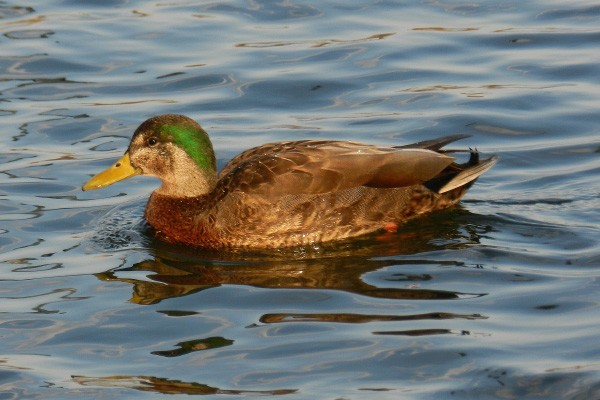
Drake American Black Duck × Mallard, Prospect Park, Brooklyn, New York, USA, February 2013
A typical 'mid-range' hybrid with plumage an almost perfect mix between the two parent species, with partial green colouring to the head, brownish body with some greyish vermiculated flank feathers, curly tail feathers, extensively pale outer tail and a warm brown colour to the breast (Photo: Séamus Feeney).
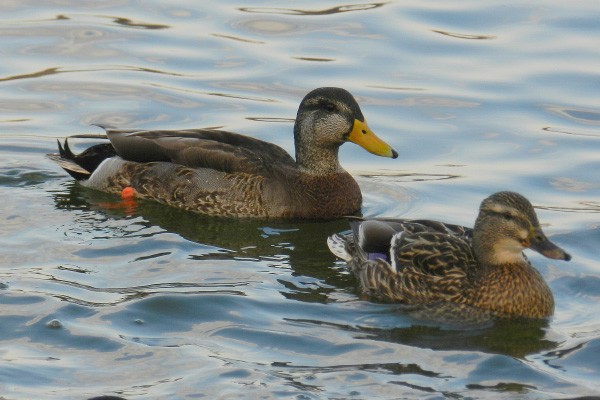
Drake American Black Duck × Mallard, Prospect Park, Brooklyn, New York, USA, February 2013
A more Mallard-like bird, but lacking most of the iridescent green head colouring and displaying brown, female-like flank feathering and dark upperparts (Photo: Séamus Feeney).
History of breeding attempts in Britain and Ireland
One of two American Black Ducks found on Tresco (Scilly) on 27th October 1976, representing the sixth record for the British Isles, became particularly fond of the island, on which it was largely resident until autumn 1983. This particular female went on to breed with a drake Mallard at least six times, producing some 22 hybrid young. Her first brood of seven in 1978 was her greatest success; four of these offspring remained to October and one stayed into the following year, when three more hybrids were raised. Two young were produced in 1980 but swiftly vanished and two hybrids, possibly from previous year, appeared that autumn. The bird produced three hybrid offspring in 1981, four in 1982 and three in its final year on the islands, 1983. Four hybrids continued to be seen to 1985 and it is thought that at least one of these offspring survived on the islands to December 1989.
Although the Isles of Scilly bird of the '70s and '80s was the most prolific parent of American Black Duck × Mallard hybrids in the British Isles, there have been numerous other instances of breeding behaviour. A drake American Black Duck inhabited Aber (Gwynedd) for a similarly impressive length of time, appearing in 1979 and last being seen in January 1985; this bird was ostensibly alluring enough to at least one local female Mallard as three fully grown hybrid young were seen there in autumn 1980 and up to three hybrids were recorded in the latter part of 1981. Mating was observed in both 1982 and 1983 and it seems likely that at least one of these years' efforts paid off as a minimum of eight hybrids were noted on 3rd September 1983. No breeding behaviour was reported in 1984 but up to eight hybrids were seen that autumn.
Elsewhere, a drake at North Kessock (Highland), which arrived on 11 October 1981, was paired with a female Mallard by the time it disappeared on 2nd March 1982. It resurfaced at the site from 7th–12th August that year, when it mated with what was possibly the same female Mallard, but it was not seen afterwards. A female which arrived at Tyninghame (Lothian) on 9th February 1985 was seen intermittently until 27th April the next year; it paired with a drake Mallard in both years, although no young were reported. The drake American Black Duck found at Achill Island (Co Mayo) from 8th January 2001 to at least 19th January 2014 has proved to be the longest stayer in the British Isles so far, and sightings of hybrids indicate successful breeding activity with Mallard locally; at least three were at the site in August 2010 with ones and twos seen intermittently in to 2014.
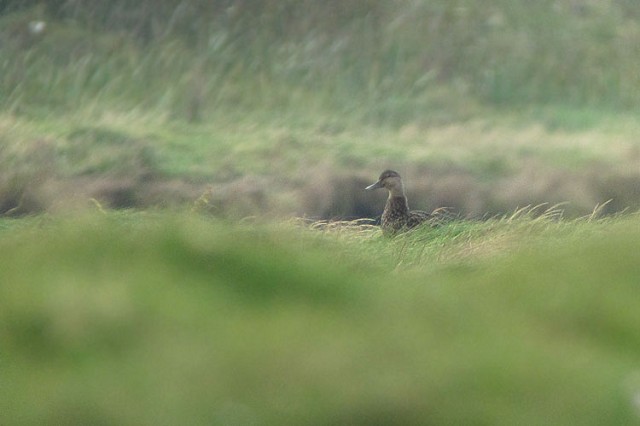
Female hybrid American Black Duck × Mallard, Achill Island, Mayo, 22 September 2011
A dark, American Black Duck-like bird but slightly on the pale side with extensive pale fringing to the flank and neck feathers. The bird also showed broad white bars on either side of the speculum (Photo: Josh Jones).
Colliford Reservoir and other sites in Cornwall supported another drake American Black Duck sporadically from 1999 until the last sighting on 16th September 2009. Four hybrids were present at one of the sites this bird regularly visited, Crowdy Reservoir, in autumn 2004, signalling the potential occurrence of breeding with a Mallard, as did hybrids reported from Colliford Lake in January 2001 and March 2002. Further hybrid records in recent years include a well-photographed drake at Musselburgh (Lothian) in September 2009, and another drake in Dingle Harbour (Kerry) in February 2008 — though hybrids were never otherwise reported during its stay, the drake at nearby Ventry (present on and off from October 2006 to September 2011) was always in close association with local Mallards and breeding must have been a distinct possibility.
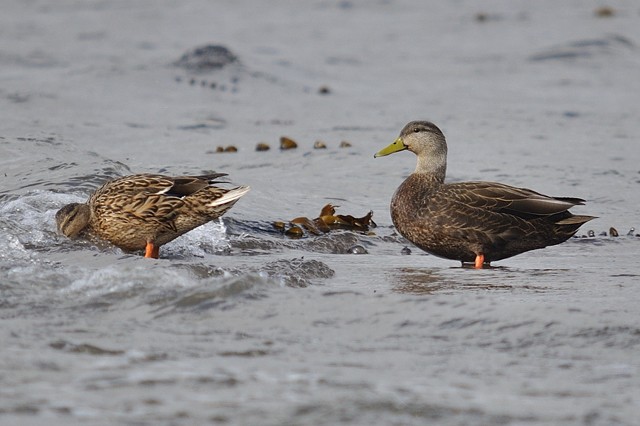
Drake American Black Duck with female Mallard, Ventry, Kerry (Photo: Ronan McLaughlin).
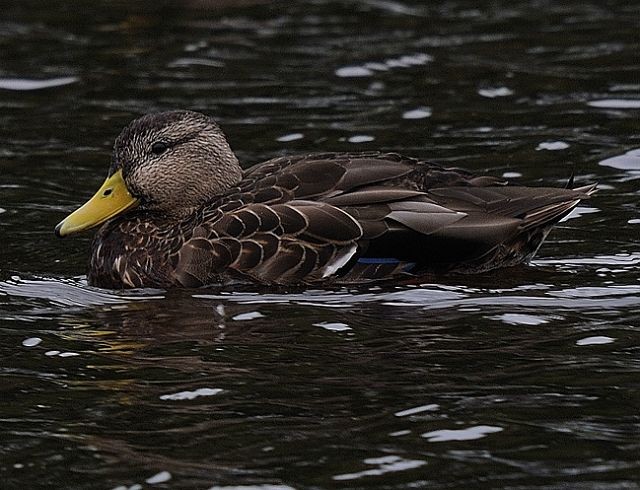
Drake hybrid American Black Duck × Mallard, Musselburgh, Lothian, September 2009
Again, quite American Black Duck-like but with obvious pale fringing to the tail edges and undertail as well as broad white edging to the speculum and pale centres to some flank and breast feathers. Note also the presence of one or two greyish, vermiculated flank feathers, betraying Mallard influence (Photo: Mike Thrower).
Black Ducks breeding in the wider WP
Instances of Black Duck hybridising with Mallard in the Western Palearctic are nowhere more frequent than in the Azores. The relative youth of Azorean ornithology probably accounts for the archipelago's first record not coming until 1967 (the upsurge in observer coverage there since 2000 occurred alongside over 60 per cent of American Black Duck records in the Azores). The lakes of Flores have been an apparent hotbed of American Black Duck/Mallard hybridisation ever since the inception of regular coverage in the late 1990s, with small gatherings of hybrids, pure American Black Ducks and Mallards resident on the island — many, if not all, of the former having presumably been raised locally.
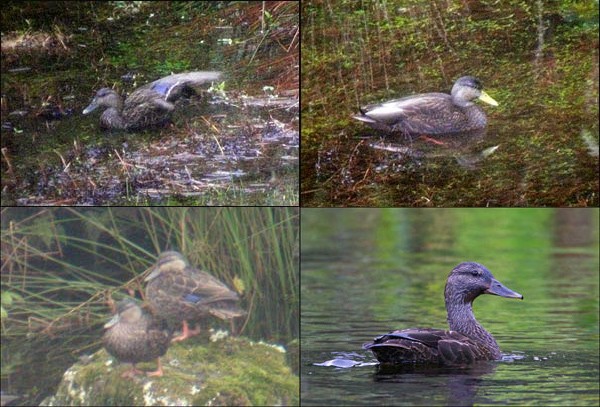
An assortment birds from Flores (Azores). Top: female (left) and drake (right) American Black Duck × Mallard hybrids, Lagoa Seca, 25 February 2011 (Photos: Olof Jönsson). Bottom left: two hybrids, Lagoa Seca, 22 October 2002 (Photo: Peter Alfrey). Bottom right: female American Black Duck or hybrid, Moinho Fields, 17 October 2011 (Photo: Mika Bruun).
Recent proof of breeding includes an apparent female American Black Duck photographed with three ducklings in June 2008 (Hering 2008); these birds were alongside at least two drake American Black Ducks and at least one hybrid. It seems highly likely, therefore, that pure pairs of American Black Duck have bred on the island in the past, but the minefield of hybrids nevertheless clouds the issue quite severely — conclusive proof would only be possible with intensive survey work throughout the breeding season, the likes of which has not yet been carried out. Reported numbers of pure American Black Ducks include five between August 2000 and February 2001, while individual counts of hybrids reached at least seven in September 2001 and in 2005/2006 — again, though, it is difficult to establish the exact numbers without a co-ordinated census and close scrutiny of each individual bird. Given the Azores' propensity for attracting vagrant birds, this small population is undoubtedly supplemented by additional vagrant American Black Ducks (and also Mallards), which in turn may go on to add to the genetic melting pot that is apparent on Flores.
Notable records from other islands include regular reports of up to two pure American Black Ducks and several hybrids at Caldeirão, Corvo, until at least autumn 2013. Many of these are presumably visiting birds from Flores — wildfowl (and other birds) have been known to commute between the two islands.
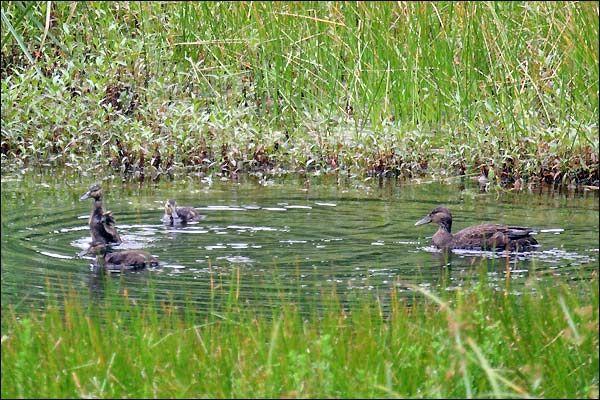
Female American Black Duck with three ducklings on the lagoon below Miradouro Craveiro Lopez, Flores, 12th June 2008. This was seemingly the first instance of apparently pure American Black Ducks breeding within the Western Palearctic (Photo: Jens Hering).
In the Faroe Islands, a long-staying drake American Black Duck, first found at Tórshavn on 10th January 2003 and staying in the area until at least winter 2010/11, is also suspected to have sired a number of offspring: several hybrids were seen within the vicinity of the original bird's favoured pond in the years following its arrival. Another long-stayer on the archipelago at Klaksvík may also have sired offspring.
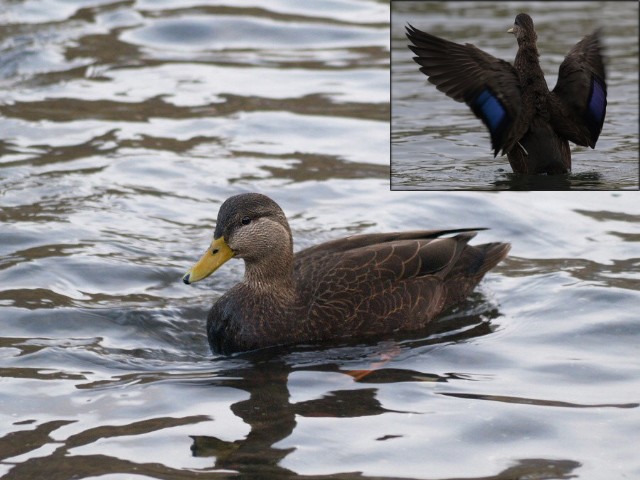
Drake American Black Duck, Klaksvík, Faroe Islands, December 2006 and (inset) September 2007 (Photos: Silas Olofson).
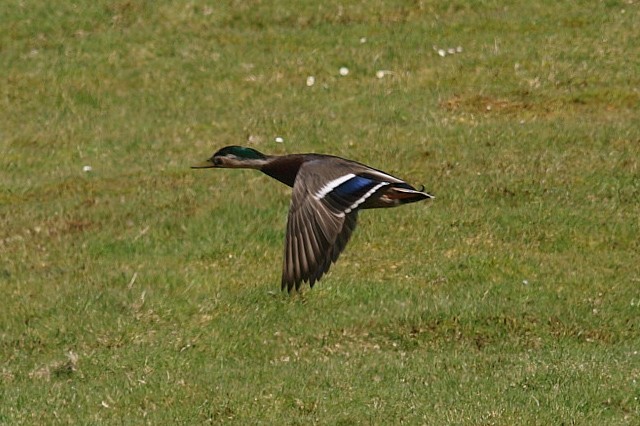
Drake American Black Duck × Mallard hybrid, Viðareiði, Faroe Islands, 17th May 2010 (Photo: Silas Olofson).
American Black Ducks also occur regularly in Iceland and four hybrids had been recorded there by the end of 2009. Only one of these hybrids was seen at the site of a long-staying American Black Duck, but was only reported once, so there is no concrete evidence for mixed breeding in Iceland, although it is certainly possible that it has occurred.
Conclusion
The American Black Duck at Strontian represents another intriguing chapter in the species' relatively short — and somewhat unique — history in the British Isles and wider Western Palearctic. It seems that, once on this side of the Atlantic, many American Black Ducks — particularly drakes — are quite happy to establish themselves within local populations of Mallards, perhaps even losing the migratory instinct that brought them here in the first place. Once settled, interspecific competition becomes a feature as the urge to reproduce results in vagrant American Black Ducks often challenging their Mallard congeners for the right to mate. As observed in eastern North America, Mallards seem to find American Black Ducks irresistible (and vice versa), and this inevitably leads to the production of hybrids. Given that both species seem capable of living prolonged lives, the reality is that a single vagrant American Black Duck in Western Europe can have the capability of producing large numbers of hybrids over several breeding seasons.
These incidences are essentially condensed, isolated examples of the 'hybrid swarm' observed in eastern North America, which is threatening American Black Duck populations within their native range. This is perhaps nowhere more apparent than on the Azorean island of Flores, where an established resident population of Mallard, American Black Ducks and hybrids continues to breed freely, and is presumably supplemented by the occasional arrival of new vagrant American Black Ducks from North America, as well as Mallards from either side of the Atlantic.
It will be interesting to see how this season progresses and, when (if) the Strontian bird reappears, whether it has added to the small flotilla of hybrids already associating with Loch Sunart's Mallard population.
Resources & acknowledgements
Hering, J. 2008. Erster Brutnachweis der Dunkelente Anas rubripes für die Westpaläarktis auf den Azoren. Limicola, vol. 22, pp. 181-187.
Thanks to Yann Kolbeinsson for information on American Black Ducks in Iceland, and Peter Alfrey, Mika Bruun, Jens Hering and Olof Jönsson for photos of Azorean birds.
The following websites provided information on a number of records:
Birding Azores rare birds database
www.tarsiger.com
www.netfugl.dk


